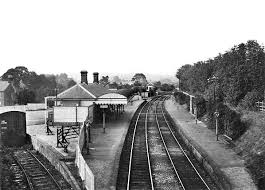
The station building at Lyminge was of Kentish clapboard beneath a hipped slate roof. A wide canopy, with a curved cross section and attractive valance, sheltered the platform; a smaller canopy was provided above the entrance door from the forecourt. The building comprised from north to south: gents toilets, ladies room, general waiting room, booking hall, booking office and stationmaster's office. At the north end of the building there was a lamp room, coal store and a clapboarded roader shed for handling large items such a barrels and crates. A standard SER clapboard waiting shelter was provided on the up platform. A footbridge was never provided at the station, with passengers having to use a barrow crossing at each end of the platform.
A livestock market was established in Lyminge in 1904 mainly for the trading of sheep. The market in Station Road, two hundred yards south of the station, had its own dock and pens adjacent to the up line. The market was very busy between 1922 and 1939, with up to 205 wagons being loaded with sheep on one day. The coming of the railway was probably responsible for the market opening, and the closure of the railway in 1947 was partly responsible for its end. During the 1950s the markets became less frequent. Furniture sales were added in an attempt to diversify, but by the mid 1960s the market building had become so dilapidated and unsafe that no further markets could be held there.
During September 1915 King George V and Lord Kitchener arrived at Lyminge station by royal train; they then rode on horseback to Beachborough House to inspect the Canadian troops who were billeted there.
Lyminge was the largest village and the busiest passenger station on the line, and the station was well sited in the centre of the village. In the year ending September 1940 (the only year for which figures survive) 16,548 passenger tickets were issued (compared with 4,946 at all the other stations combined) and 7,438 were collected. 646 parcels were sent and 2,129 were received. 38 tons of general merchandise were received - which is a lot more than at any other station on the line - and 231 tons dispatched. Livestock traffic at the old horse dock was negligible: six horses accounted for the entire year’s traffic. This does not, however, take account of traffic from the livestock market, with its own dock south of the station. Lyminge still handled considerable quantities of both coal and milk with 1,807 tons of coal being received and 2,747 cans of milk; in addition 312 cans of milk were dispatched.
On 25 October 1940 the passenger and goods services north of Lyminge were suspended when the line came under military control, but the service between Folkestone and Lyminge continued to run until 3 May 1943. The Elham Valley Military Railway provided its own passenger trains for military personnel, but members of the public were allowed to travel on these at their own risk. Special tickets were issued. Extra sidings, for military use, were laid north of Lyminge station to accommodate two 12-inch railway guns which arrived shortly after the evacuation of Dunkirk; after an air raid they were moved to Elham.
The goods service was reinstated on 19 February 1945, and a passenger shuttle between Folkestone and Lyminge started running on 7 October 1946 with six trains Monday, Friday and seven on Saturday, but no Sunday service. The passenger service had been reinstated reluctantly by the Southern Railway, and it was very short-lived as most passengers had switched to more convenient road transport, with 14 buses along the valley road seven days a week. Some trains were almost empty, so it came as no surprise when the line closed, with the passenger service being withdrawn from 16 June 1947. Goods trains continued to run on Mondays, Wednesdays and Fridays until alternative road transport had been arranged. The line closed completely on 1 October 1947, and the track through Lyminge was lifted in the late summer of 1953.
The old station building has been used as Lyminge Library since the 1980s